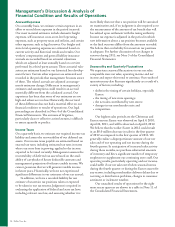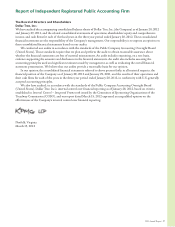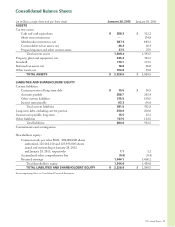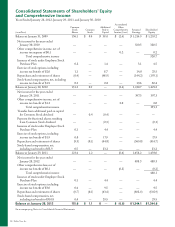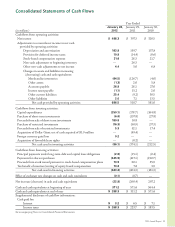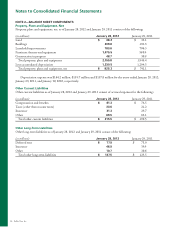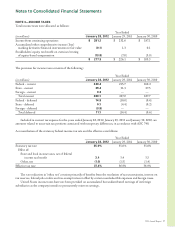Dollar Tree 2011 Annual Report Download - page 35
Download and view the complete annual report
Please find page 35 of the 2011 Dollar Tree annual report below. You can navigate through the pages in the report by either clicking on the pages listed below, or by using the keyword search tool below to find specific information within the annual report.
1RWHVWR&RQVROLGDWHG)LQDQFLDO6WDWHPHQWV
Merchandise Inventories
Merchandise inventories at the Company’s distribu-
tion centers are stated at the lower of cost or market,
determined on a weighted-average cost basis. Cost is
assigned to store inventories using the retail inventory
method on a weighted-average basis. Under the retail
inventory method, the valuation of inventories at cost
and the resulting gross margins are computed by applying
a calculated cost-to-retail ratio to the retail value of
inventories. From its inception through fiscal 2009, the
Company used one inventory pool for this calculation.
Because of investments over the years in retail technology
systems, the Company was able to refine the estimate of
inventory cost under the retail method. On January 31,
2010, the first day of fiscal 2010, the Company began
using approximately thirty inventory pools in its retail
inventory calculation. As a result of this change, the
Company recorded a non-recurring, non-cash charge to
gross profit and a corresponding reduction in inventory,
at cost, of approximately $26.3 million in the first quarter
of 2010. is was a prospective change and did not
have any effect on prior periods. is change in estimate
to include thirty inventory pools in the retail method
calculation is preferable to using one pool in the calcula-
tion as it gives the Company a more accurate estimate of
cost of store level inventories.
Costs directly associated with warehousing and
distribution are capitalized as merchandise inventories.
Total warehousing and distribution costs capitalized into
inventory amounted to $34.5 million and $30.8 million
at January 28, 2012 and January 29, 2011, respectively.
Property, Plant and Equipment
Property, plant and equipment are stated at cost and
depreciated using the straight-line method over the
estimated useful lives of the respective assets as follows:
Buildings 39 to 40 years
Furniture, fixtures and equipment 3 to 15 years
Leasehold improvements and assets held under capital
leases are amortized over the estimated useful lives of the
respective assets or the committed terms of the related
leases, whichever is shorter. Amortization is included
in “selling, general and administrative expenses” in the
accompanying consolidated statements of operations.
Costs incurred related to software developed for
internal use are capitalized and amortized generally over
three years.
Goodwill
Goodwill is not amortized, but rather tested for impair-
ment at least annually. In addition, goodwill will be tested
on an interim basis if an event or circumstance indicates
that it is more likely than not that an impairment loss
has been incurred. e Company performed its annual
impairment testing in November 2011 and determined
that no impairment loss existed.
Other Assets, Net
Other assets, net consists primarily of restricted invest-
ments and intangible assets. Restricted investments were
$83.6 million and $72.1 million at January 28, 2012
and January 29, 2011, respectively and were purchased
to collateralize long-term insurance obligations. ese
investments consist primarily of government-sponsored
municipal bonds, similar to the Company’s short-term
investments held at the end of fiscal 2010 and money
market securities. ese investments are classified as
available for sale and are recorded at fair value, which
approximates cost. Intangible assets primarily include
favorable lease rights with finite useful lives and are
amortized over their respective estimated useful lives.
Impairment of Long-Lived Assets and
Long-Lived Assets to Be Disposed Of
e Company reviews its long-lived assets and certain
identifiable intangible assets for impairment whenever
events or changes in circumstances indicate that the
carrying amount of an asset may not be recoverable.
Recoverability of assets to be held and used is measured
by comparing the carrying amount of an asset to future
net undiscounted cash flows expected to be generated by
the asset. If such assets are considered to be impaired, the
impairment to be recognized is measured as the amount
by which the carrying amount of the assets exceeds the
fair value of the assets based on discounted cash flows or
other readily available evidence of fair value, if any. Assets
to be disposed of are reported at the lower of the carrying
amount or fair value less costs to sell. In fiscal 2011, 2010
and 2009, the Company recorded charges of $0.9 million,
$1.1 million and $1.3 million, respectively, to write down
certain assets. ese charges are recorded as a component
of “selling, general and administrative expenses” in the
accompanying consolidated statements of operations.
2011 Annual Report 33



